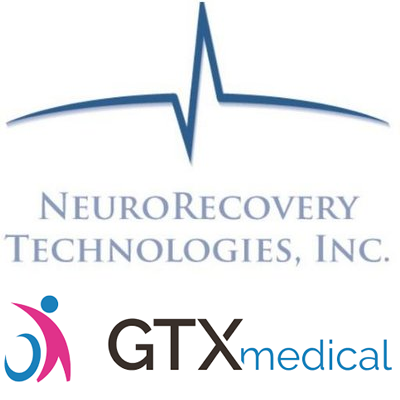GTX Medical and NeuroRecovery Technologies merge - Reeve Foundation
 People living with spinal cord injury have long clamored for faster translation of basic discoveries out of the lab and into the clinic. I believe the announcement of a merger between GTX Medical and NeuroRecovery Technologies, and the attendant consolidation of transcutaneous and epidural neuromodulation intervention patents from multiple universities around the world into a single robust IP portfolio, is an example of much-needed translation happening in the here and now. The same management team that successfully built and sold a Parkinson's disease deep brain stimulation company to medical devices powerhouse Medtronic is at the helm at the merged company, GTX for short. Auspiciously, this merger happened in the same week as the approval by FDA of a triple-combination therapy for cystic fibrosis, the result of nearly two decades of venture philanthropy and productive nonprofit/for-profit collaboration between Vertex Pharmaceuticals and the Cystic Fibrosis Foundation that I believe serves as a north star for the Christopher & Dana Reeve Foundation.
People living with spinal cord injury have long clamored for faster translation of basic discoveries out of the lab and into the clinic. I believe the announcement of a merger between GTX Medical and NeuroRecovery Technologies, and the attendant consolidation of transcutaneous and epidural neuromodulation intervention patents from multiple universities around the world into a single robust IP portfolio, is an example of much-needed translation happening in the here and now. The same management team that successfully built and sold a Parkinson's disease deep brain stimulation company to medical devices powerhouse Medtronic is at the helm at the merged company, GTX for short. Auspiciously, this merger happened in the same week as the approval by FDA of a triple-combination therapy for cystic fibrosis, the result of nearly two decades of venture philanthropy and productive nonprofit/for-profit collaboration between Vertex Pharmaceuticals and the Cystic Fibrosis Foundation that I believe serves as a north star for the Christopher & Dana Reeve Foundation.
The journey of a triple-combo therapy for cystic fibrosis and the journey of "neurostim" for SCI parallel each other historically, give or take a decade. Professor Reggie Edgerton at UCLA, whose lab and whose disciples have been funded to the tune of tens of millions of dollars by the Reeve Foundation over decades, is the undisputed godparent of neuromodulation; and the labs of Professors Susan Harkema at the University of Loiusville and Gregoire Courtine at EPFL, were engines of discovery and critical testing grounds. The central pattern generator model dates back the 60s and 70s. With neurostim, injured rats were turned into little Lazaruses on laboratory treadmills in the 90s and 00s. The SCI community has anticipated the clinical promise of neurostimulation and The Big Idea for some time. There are 1.3M Americans, and millions more worldwide, living with paralysis and they want to know when help will arrive.
Mutations that cause cystic fibrosis were painstakingly mapped to the CFTR gene in 1989. For the first ten years after the cloning of the gene, nothing much happened in terms of translation. This is (alas) typical of drug discovery and development, a failure-prone multi-step process that on average takes 15 years to develop an approved product from proof of concept. Translational progress began in earnest when the Cystic Fibrosis Foundation partnered with a small San Diego-based biotech called Aurora Biosciences, which was later acquired by Vertex Pharmaceuticals. When given the chance to double down on their cystic fibrosis bet or walk away, the management team at Vertex stuck by the cystic fibrosis community. The first drug of the triple combo was approved in 2013. The second drug was approved two years later. The third drug went from drawing board to tablet in three years. Accelerating translation is the goal.
Let's return to the question on everyone's mind: how will the SCI community benefit from neuromodulation therapies NOW? With the GTX team at the helm and under the leadership of Sjaak Deckers, the number of clinical sites will increase. I can't speak for the GTX management team in terms of their specific timelines, but I can comment generally on where I think neuromodulation therapies fit into the SCI Cure Roadmap that I've begun to draft.
There are known knowns. Neurostim won't work for all people living with SCI. There will be non-responders of course but there will also be hyper-responders, people who respond better than expected to intervention. We will learn a ton from both groups, as outliers often hold the key to unlocking mechanistic insights into how therapies actually work in people. There will be next-generation devices. SCI patients will surely use their phones and apps to control devices and crowdsource rehab protocols.
I see neuromodulation as not only part of the post-acute phase "salvage and recovery" operation that takes place after the injury but also as a bridging therapy on the path toward neuroplasticity and neuroregeneration. I'm most interested in seeing how neuromodulation therapies aka "electroceuticals" can be brought to bear as quickly and safely as possible in order to maximize performance and plasticity of spared axons and circuitry in the chronic setting. I'm also keenly interested in how can neuromodulation therapies can be applied to quality of life wins like blood pressure management, bladder, bowel and sexual function – not just movement, as important as it is. The Big Idea is already using cardiovascular outcomes and I believe this clinical endpoint is poised for a home run.
Join Our Movement
What started as an idea has become a national movement. With your support, we can influence policy and inspire lasting change.
Become an Advocate